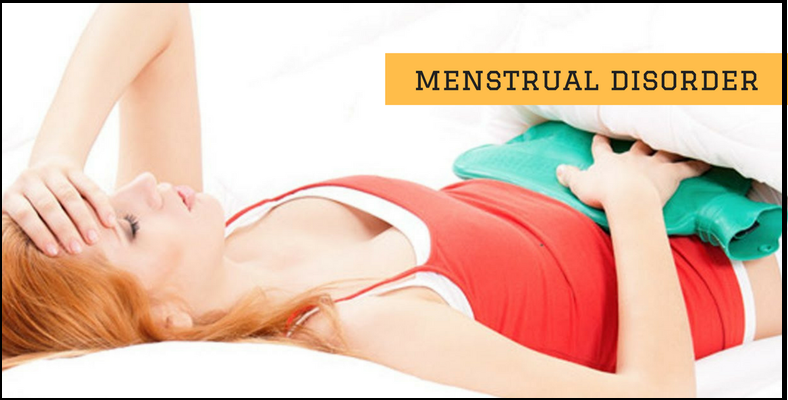
Menstrual Disorder
- Description
- Faq's
Some women get through their monthly periods easily with few or no concerns. Their periods come like clockwork, starting and stopping at nearly the same time every month, causing little more than a minor inconvenience.
However, other women experience a host of physical and/or emotional symptoms just before and during menstruation. From heavy bleeding and missed periods to unmanageable mood swings, these symptoms may disrupt a woman's life in major ways. Most menstrual cycle problems have straightforward explanations, and a range of treatment options exist to relieve your symptoms. If your periods feel overwhelming, discuss your symptoms with your health care professional. Once your symptoms are accurately diagnosed, he or she can help you choose the best treatment to make your menstrual cycle tolerable.How the Menstrual Cycle Works
Your menstrual period is part of your menstrual cycle—a series of changes that occur to parts of your body (your ovaries, uterus, vagina and breasts) every 28 days, on average. Some normal menstrual cycles are a bit longer; some are shorter. The first day of your menstrual period is day one of your menstrual cycle. The average menstrual period lasts about five to seven days. A "normal" menstrual period for you may be different from what's "normal" for someone else.
Types of Menstrual Disorders
If one or more of the symptoms you experience before or during your period causes a problem, you may have a menstrual cycle "disorder." These include:
- Abnormal Uterine Bleeding (AUB) Which may include heavy menstrual bleeding, no menstrual bleeding (amenorrhea) or bleeding between periods (irregular menstrual bleeding)
- dysmenorrhea (painful menstrual periods)
- premenstrual syndrome (PMS)
- premenstrual dysphonic disorder (PMDD)
A brief discussion of menstrual disorders follows below.
Heavy menstrual bleeding
One in five women bleed so heavily during their periods that they have to put their normal lives on hold just to deal with the heavy blood flow.
Bleeding is considered heavy if it interferes with normal activities. Blood loss during a normal menstrual period is about 5 tablespoons, but if you have heavy menstrual bleeding, you may bleed as much as 10 to 25 times that amount each month. You may have to change a tampon or pad every hour, for example, instead of three or four times a day. Heavy menstrual bleeding can be common at various stages of your life—during your teen years when you first begin to menstruate and in your late 40s or early 50s, as you get closer to menopause. If you are past menopause and experience any vaginal bleeding, discuss your symptoms with your health care professional right away. Any vaginal bleeding after menopause isn't normal and should be evaluated immediately by a health care professional.Heavy menstrual bleeding can be caused by:
- hormonal imbalances
- structural abnormalities in the uterus, such as polyps or fibroids
- medical conditions
Many women with heavy menstrual bleeding can blame their condition on hormones. Your body may produce too much or not enough estrogen or progesterone—known as reproductive hormones—necessary to keep your menstrual cycle regular.
For example, many women with heavy menstrual bleeding don't ovulate regularly. Ovulation, when one of the ovaries releases an egg, occurs around day 14 in a normal menstrual cycle. Changes in hormone levels help trigger ovulation.Certain medical conditions can cause heavy menstrual bleeding. These include:
- thyroid problems
- blood clotting disorders such as Von Willebrand's disease, a mild-to-moderate bleeding disorder
- idiopathic thrombocytopenic purpura (ITP), a bleeding disorder characterized by too few platelets in the blood
- liver or kidney disease
- leukemia
- medications, such as anticoagulant drugs such as Plavix (clopidogrel) or heparin and some synthetic hormones.
Other gynecologic conditions that may be responsible for heavy bleeding include:
- complications from an IUD
- fibroids
- miscarriage
- ectopic pregnancy, which occurs when a fertilized egg begins to grow outside your uterus, typically in your fallopian tubes
Other causes of excessive bleeding include:
- infections
- precancerous conditions of the uterine lining cells
Amenorrhea
You may also have experienced the opposite problem of heavy menstrual bleeding—no menstrual periods at all. This condition, called amenorrhea, or the absence of menstruation, is normal before puberty, after menopause and during pregnancy. If you don't have a monthly period and don't fit into one of these categories, then you need to discuss your condition with your health care professional.
There are two kinds of amenorrhea: primary and secondary.
- Primary amenorrhea is diagnosed if you turn 16 and haven't menstruated. It's usually caused by some problem in your endocrine system, which regulates your hormones. Sometimes this results from low body weight associated with eating disorders, excessive exercise or medications. This medical condition can be caused by a number of other things, such as a problem with your ovaries or an area of your brain called the hypothalamus or genetic abnormalities. Delayed maturing of your pituitary gland is the most common reason, but you should be checked for any other possible reasons.
- Secondary amenorrheais diagnosed if you had regular periods, but they suddenly stop for three months or longer. It can be caused by problems that affect estrogen levels, including stress, weight loss, exercise or illness.
Additionally, problems affecting the pituitary gland (such as elevated levels of the hormone prolactin) or thyroid (including hyperthyroidism or hypothyroidism) may cause secondary amenorrhea. This condition can also occur if you've had an ovarian cyst or had your ovaries surgically removed.
Severe menstrual cramps (dysmenorrhea)
Most women have experienced menstrual cramps before or during their period at some point in their lives. For some, it's part of the regular monthly routine. But if your cramps are especially painful and persistent, this is called dysmenorrhea, and you should consult your health care professional.
Pain from menstrual cramps is caused by uterine contractions, triggered by prostaglandins, hormone-like substances that are produced by the uterine lining cells and circulate in your bloodstream. If you have severe menstrual pain, you might also find you have some diarrhea or an occasional feeling of faintness where you suddenly become pale and sweaty. That's because prostaglandins speed up contractions in your intestines, resulting in diarrhea, and lower your blood pressure by relaxing blood vessels, leading to lightheadedness.Premenstrual syndrome (PMS)
PMS is a term commonly used to describe a wide variety of physical and psychological symptoms associated with the menstrual cycle. About 30 to 40 percent of women experience symptoms severe enough to disrupt their lifestyles. PMS symptoms are more severe and disruptive than the typical mild premenstrual symptoms that as many as 75 percent of all women experience.
There are more than 150 documented symptoms of PMS, the most common of which is depression. Symptoms typically develop about five to seven days before your period and disappear once your period begins or soon after.Physical symptoms associated with PMS include:
- bloating
- swollen, painful breasts
- fatigue
- constipation
- headaches
- clumsiness
Emotional symptoms associated with PMS include:
- anger
- anxiety or confusion
- mood swings and tension
- crying and depression
- inability to concentrate
PMS appears to be caused by rising and falling levels of the hormones estrogen and progesterone, which may influence brain chemicals, including serotonin, a substance that has a strong affect on mood. It's not clear why some women develop PMS or PMDD and others do not, but researchers suspect that some women are more sensitive than others to changes in hormone levels.
PMS differs from other menstrual cycle symptoms because symptoms:
- tend to increase in severity as the cycle progresses
- are relieved when menstrual flow begins or shortly after
- are present for at least three consecutive menstrual cycles
- PMDD-related symptoms (both emotional and physical) are cyclical. When a woman starts her period, the symptoms subside within a few days.
- Depression-related symptoms, however, are not associated with the menstrual cycle. Without treatment, depressive mood disorders can persist for weeks, months or years. If depression persists, you should consider seeking help from a trained therapist.
Symptoms of PMS may increase in severity following each pregnancy and may worsen with age until they stop at menopause. If you experience PMS, you may have an increased sensitivity to alcohol at specific times during your cycle. Women with this condition often have a sister or mother who also suffers from PMS, suggesting a genetic component exists for the disorder.
Premenstrual Dysphoric Disorder (PMDD)
Premenstrual dysphoric disorder is far more severe than the typical PMS. Women who experience PMDD (about 3 to 8 percent of all women) say it significantly interferes with their lives. Experts equate the difference between PMS and PMDD to the difference between a mild tension headache and a migraine.
The most common symptoms of PMDD are heightened irritability, anxiety and mood swings. Women who have a history of major depression, postpartum depression or mood disorders are at higher risk for PMDD than other women. Although some symptoms of PMDD and major depression overlap, they are different: